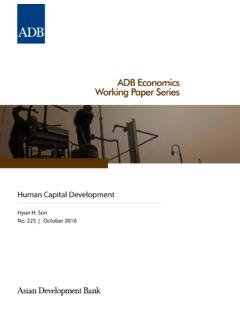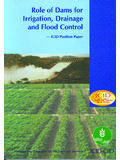Transcription of Environmental Issues, Climate Changes, and Energy …
1 ADB ECONOMICSWORKING PAPER SERIESENVIRONMENTAL ISSUES, Climate CHANGES, AND Energy SECURITY IN DEVELOPING ASIAB enjamin K. SovacoolNO. 399 June 2014 ASIAN DEVELOPMENT BANKADB Economics Working Paper SeriesEnvironmental Issues, Climate Changes, and Energy Security in Developing AsiaBenjamin K. SovacoolNo. 399 2014 Benjamin K. Sovacool is Associate Professor at Vermont Law School, and Professor of Business and Social Sciences at Aarhus UniversityAsIAn deVeLoPMent BAnKAsian Development Bank6 ADB Avenue, Mandaluyong City1550 Metro Manila, 2014 by Asian Development BankJune 2014 ISSN 1655-5252 Publication Stock No. WPS146535 The views expressed in this paper are those of the author and do not necessarily reflect the views and policies of the Asian Development Bank (ADB) or its Board of Governors or the governments they does not guarantee the accuracy of the data included in this publication and accepts no responsibility for any consequence of their making any designation of or reference to a particular territory or geographic area, or by using the term country in this document, ADB does not intend to make any judgments as to the legal or other status of any territory or.
2 In this publication, $ refers to US ADB Economics Working Paper Series is a forum for stimulating discussion and eliciting feedback on ongoing and recently completed research and policy studies undertaken by the Asian Development Bank (ADB) staff, consultants, or resource persons. The series deals with key economic and development problems, particularly those facing the Asia and Pacific region; as well as conceptual, analytical, or methodological issues relating to project/program economic analysis, and statistical data and measurement. The series aims to enhance the knowledge on Asia s development and policy challenges; strengthen analytical rigor and quality of ADB s country partnership strategies, and its subregional and country operations; and improve the quality and availability of statistical data and development indicators for monitoring development effectiveness.
3 The ADB Economics Working Paper Series is a quick-disseminating, informal publication whose titles could subsequently be revised for publication as articles in professional journals or chapters in books. The series is maintained by the Economics and Research Department. Printed on recycled paperCONTENTSABSTRACT I. INTRoDUCTIoN 1 II. Climate change 2 III. AIR PoLLUTIoN 5 IV. WATER QUALITy AND AVAILABILITy 6 V. LAND-USE change 8 VI. Environmental IMPACT of Energy TEChNoLoGy oPTIoNS 10 A. Energy Efficiency 10 B. Nuclear Power 11 C. Shale Gas 11 D. Conventional Coal 12 E. Clean Coal 12 f. oil and Natural Gas 13 G. hydroelectricity 14 h. Wind Energy 14 I. Solar Photovoltaics 15 J. Solar Thermal 15 K. Geothermal 15 L. Biomass 15 M. Biofuels 16 VII. CoNCLUSIoNS 16 REfERENCES 18 AbSTrACTfour Environmental dimensions of Energy security Climate change , air pollution, water availability and quality, and land-use change and the Environmental impact of 13 Energy systems on each are discussed in this paper.
4 Climate change threatens more land, people, and economies in Asia and small Pacific island states than any other part of the planet. Air pollution takes a substantial toll on national health-care expenditures and economies in general. of the 18 megacities worldwide with severe levels of total suspended particulate matter emissions, 10 are in Asia. Regarding water availability and quality, hydropower, nuclear power, and thermal power account for 10% to 15% of global water consumption, and the volume of water evaporated from reservoirs exceeds the combined freshwater needs of industry and domestic consumption. In the domain of Climate change , rising sea levels could contaminate freshwater aquifers possibly reducing potable water supplies by 45%. Changes in land use for fuelwood collection and biofuel production in Southeast Asia have resulted in deforestation at 5 times the global average and 10 times the average for the rest of Asia.
5 Policymakers must begin to incorporate the cost of these negative consequences into Energy : environment, water policy, Climate change , Energy security, Asia-PacificJEL: Q40, Q43, Q511 Asia s Energy Adequacy, Environmental Sustainability, and Affordability: An overviewI. IntroductIon This study explores the intersection of Environmental constraints, Climate change , and Energy security in Asia and the Pacific. Although Environmental sustainability has only recently emerged as an Energy policy issue , the magnitude of Energy impacts on Environmental systems suggests strong links to Energy security. The unchecked growth in fossil Energy consumption and the ensuing acceleration of global Climate change as well as related air and water pollution act as threat multipliers impinging on national security globally. These Environmental dimensions are just a subset of a larger array of Environmental concerns that threaten Energy security including land pollution, forestry, and biodiversity Table 1 summarizes the four Environmental dimensions of Energy security in Asia and the Pacific discussed in this chapter: Climate change , air pollution, water availability and quality, and land-use 1: Environmental Dimensions of Energy Security in Asia and the PacificDimensionLink To Energy SecurityEnergy Contribution To The Problem Climate change Climate change is a threat multiplier in terms of Energy security.
6 Mass migrations of refugees seeking asylum from ecological disasters could destabilize regions of the world threatening Energy as well as national total of of global carbon dioxide emissions come from Energy supply and Pollution Deterioration of Environmental conditions can negatively impact human and ecological health with significant numbers of premature deaths related to indoor and outdoor air pollution and significant expenditures lost in terms of lost productivity and 80% of global sulfur dioxide emissions, 80% of particulate matter emissions, and 70% of nitrogen oxide emissions come from the Energy and transport Availability and Quality Lack of available safe drinking water can destabilize the security of a region. Because fossil, hydro, and nuclear power plants consume large quantities of freshwater, shrinking supplies of water could threaten the ability to provide electricity and the ability of nations to feed all, 25% of global water supply is lost due to evaporation from reservoirs and another 10% 15% of global freshwater is used in thermoelectric power plants.
7 Land-Use change Deforestation can cause social dislocation, increase the cost of fuelwood, destroy biodiversity, and conflict with agriculture and the preservation of nature least 15% of land-use change is caused by the direct clearing of forests for fuelwood and the expansion of plantations for Energy : Modified from Brown and Dworkin (2011).1 Brown and Dworkin Economics Working Paper Series No. 399II. Climate change Climate change is a substantial Energy security concern not only because direct flooding and natural disasters can damage power plants and transmission lines, disrupt the delivery of imported Energy fuels, and destroy crops for biofuels but also because it has severe impacts on food security, health, and Environmental refugees that can all lower the income base of Asian countries and add to government debt further complicating attempts at sound Energy policy making.
8 Though Climate change is certainly a global phenomenon, in many ways it is becoming an Asian problem. figure 1 shows annual tons of carbon dioxide (Co2) emissions from fuel combustion divided by the total national population for selected Asian countries. It indicates that emissions more than doubled from 1990 to 2010 in the People s Republic of China (PRC), Indonesia, Malaysia, Thailand, and Viet Nam. figure 2 indicates that when changes in land use are included, four of the top 10 emitters of greenhouse gases (GhGs) the PRC, Indonesia, India, and Japan are in Asia. Co2 emissions from the electricity supply sector in the PRC mainly coal-fired power plants make up almost half of the total emissions generated by the country .2 In 1987, only 12% of emissions were due to industrial production, but that figure rose to 21% in 2002 and to 33% in In Taipei,China emissions jumped from million metric tons of Co2 equivalent in 1990 to million in 2000, an increase of one international assessment of the carbon footprints in 12 major metropolitan areas throughout the world in 2010 found that only four cities were below the world average and that many major ones such as Seoul, Singapore, and Tokyo were already well above 1: Per Capita Energy -Related Carbon Dioxide Emissions, 1990 and 2010 (metric tons)2520151050 Brunei DarussalamCambodiaIndonesiaLao PDRM alaysiaMyanmarPhillipinesSingaporeThaila ndViet NamPRCI ndiaJapanRep.
9 Of KoreaUnited StatesEuropean UnionAustraliaNew Zealand19902010 Lao PDR=Lao People s Democratic Republic, PRC=People s Republic of China. Source: Sovacool et al. Liu et al Weber et al Tsai and Chou Global carbon footprint of computed by dividing global emissions ( billion tons of carbon dioxide) by the world population ( billion) and again by to convert carbon dioxide to carbon. footprints include direct and responsible emissions from transport, buildings and industry, agriculture (when applicable), and waste (when applicable). See Sovacool and Brown s Energy Adequacy, Environmental Sustainability, and Affordability: An overviewFigure 2: Share of greenhouse gas Emissions in Top Ten Countries, 2010 United Canada Germany Japan India Russian Brazil Indonesia United PRCK ingdom federation States8,0007,0006,0005,0004,0003,0002,00 01,000 Million Metric Tons ofCarbon DioxideEquivalentotherWates & WastewaterAgriculture & Land UseTransportation6527471,0051,3741,4851, 5341,5783,0147,2827,527 Industry & ConstructionElectricity & Energy UsePRC=People s Republic of : Brown and Sovacool 2011.
10 Unfortunately from a Climate standpoint, the GhGs already emitted will threaten Asia with a staggering list of negative consequences. Because of their unique geography and climatology, low per capita incomes, and changing patterns of urbanization, Indonesia, the Philippines, Thailand, and Viet Nam are expected to lose of combined gross domestic product (GDP) by 2100 if temperatures change as the Intergovernmental Panel on Climate change predicts, which is more than twice the rate of global average Even uniform changes in Climate will not affect Asia equally as Cambodia, the Lao People s Democratic Republic (Lao PDR), the Mekong River Delta, the Philippines, central Thailand, and Sumatra and Java in Indonesia are more at risk than wealthier countries such as Brunei Darussalam or The PRC and India, for instance, could exhaust between 1% and 12% of their annual GDPs coping with Climate refugees, changing disease vectors, and failing one study forecasts a 37% reduction in national crop yields by 2050 in the PRC if current Climate trends Some states in India such as Maharashtra are projected to suffer greater drought that will likely wipe out 30% of food production inducing $7 billion in damages among 15 million small and marginal In India as a whole, farmers and fishers will have to migrate from coastal areas as sea levels rise and as they confront heat waves lowering crop output.











